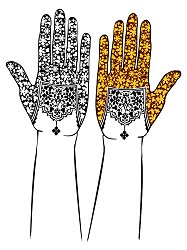
|
and Military Officers in Zand and Qajar Iran Catherine Cartwright-Jones c 2004 Kent State University The portrait of prince Rustam Khan Zand, from Shiraz in 1779, shows him with hennaed fingernails, and a small tattoo on the back of his hand. A painting by the same artist, Muhammad Sadiq, from the same period, shows embracing young lovers in courtly clothing. The woman's hands have dip henna up to the wrist, and the man has hennaed fingernails. The monumental court painting of "Karim Khan Zand and His Kinsmen" shows the group with their court robes, turbans and and swords. Most of the kin are positioned in a way that does not show their fingernails, but the man standing at the leader's right does have easily observable hennaed nails. These, and other portraits of the period, show that many, though not all, Zand ruling class and military men regularly hennaed their fingernails. Noblemen continued to henna their fingernails into the Qajar era. The portrait of a "Nobleman Wearing a Zand Turban" was done in 1796, in the early Qajar era. The portrait may be of one of the Qajar leaders in the interim before Aqa Muhammad Khan came to power. In the early Qajar period, most portraits of Fath 'Ali Shah show him with hennaed fingernails. Farther into the Qajar period, Prince Muhammad 'Ali Mirza, Dawlatshah, and Sultan Muhammad Mirza, Sayf al-Dawleh, pose holding their swords: their hands have hennaed nails. The color of their nails ranges from bright red coral, to deeper rust red. This depth of color shows that the henna must have been applied regularly, probably weekly, and must have been of high quality. There is less evidence for Iranian military officials and government leaders using henna in the late 19th century. The portraits show officers and leaders wearing gloves, or with their hands closed so the nails cannot be seen, grasping their weapons, or without hennaed nails. It is unclear from portrait evidence to what extent men continued to henna their nails into that period. The Blood of the Prey
Eyewitness
accounts expand the information gathered from portraits. European
travelers' diaries often have information about body markings, because
Europeans were unfamiliar with henna and commented on it when they saw
it. Men's Hennaed Fingernails in Afghanistan John Rattray, an English traveler to Afghanistan in the early 1800’s, was the guest of an important tribal leader, Jubber Khan. Rattray wrote in his diary that at a great feast, Jubber Khan apologized to him that the young men in his retinue did not yet have hennaed nails or fingertips. He explained this through metaphor: “the falcon dips its talons in the blood of its prey”. His implication was their lack of hennaed fingernails showed that they hadn’t yet achieved honorable status by killing an enemy. This indicates that in early 19th century Afghanistan, a man earned the right to have hennaed nails by participating in the constant inter-tribal disputes. When he had avenged the honor of his group by killing an enemy, he could display his victory and elevated prestige by hennaing his fingernails.  Pattern from Alex Morgan's book, "Warrior" patterns adapted from the weapons of war Click on image for a larger view and more of her patterns! References: Portraits: Rustam Khan Zand Muhammad Sadiq, Shiraz, 1779 Collection of Mrs. Eskandar Aryeh Embracing Lovers Muhammad Sadq, Shiraz, 1770-80 Collection of Mrs. Eskandar Aryeh Karim Khan Zand and his Kinsmen Muhammad Sadiq, Shiraz, after 1779 Collection of Mrs. Eskandar Aryeh Portrait of a Nobleman Wearing a Zand Turban Muhammad Zaman III, Shiraz, 1795 Collection of Mr. And Mrs Dara Zargar Fath 'Ali Shah Seated Mirz Baba, Tehran, 1798 Private Collections Prince Muhammad 'Ali Mirza, Dawlatshah (1788 - 1821) Ja'far, Tehran, 1820, Smithsonian Institution, LTS 1995.2.123 Portrait of Sultan Muhammad Mirza, Sayf al-Dawleh Sayyid Mirza Tehran or Isfahan, circa 1835 Private Collection Texts: Diba, L, Ekhtiar, M,; Ed. Royal Persian Paintings, The Qajar Epoch, 1785 - 1925 I. B. Taurus Publishers in association with the Brooklyn Museum of Art, 1998 Field, Henry Body-Marking in Southwestern Asia Papers of the Peabody Museum of Archaeology and Ethnology, Harvard University Vol. XLV, No 1 Peabody Museum, Cambridge Massachusetts, USA Rattray, J Costumes and Scenery of Afghaunistan Harrington and Remington, London, 1848 Return to The Encyclopedia of Henna Index Return to the War Index Can't find what you're looking for? Try: The Henna Page Main Index http://www.hennapage.com/henna/mainindex.html *"Henna,
the
Joyous Body Art"
the Encyclopedia of Henna Catherine Cartwright-Jones c 2000 registered with the US Library of Congress TXu 952-968 |
